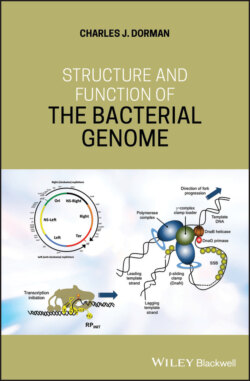Читать книгу Structure and Function of the Bacterial Genome - Charles J. Dorman - Страница 30
1.19 The Chromosome Displays Spatial Arrangement Within the Cell
ОглавлениеThe bacterial chromosome is oriented in the cytoplasm with reference to the poles and the midpoint of the cell (Figure 1.9). This positioning is important for the successful segregation of the daughter chromosomes at cell division and it assigns domains to specific regions of the cytoplasm. Experiments using fluorescence in situ hybridisation (FISH) in E. coli show that in newborn cells, Ori and Ter are located at the cell poles and that genetic loci in between follow approximately the gene order along the chromosome (Niki et al. 2000). Before the initiation of chromosome replication, Ori and Ter move to the mid‐cell position. Chromosomes with gross rearrangements of the macrodomains misplace Ori and Ter, leading to the appearance of anucleate daughter cells at cell division (Niki et al. 2000).
FISH experiments involve the permeabilisation and fixing of the bacterial cells; these treatments may produce artefacts, making less intrusive approaches more desirable. Experiments in which arrays of binding sites for fluorescently labelled DNA‐binding proteins are placed at specific chromosomal locations have allowed chromosome dynamics to be studied in live bacteria (Robinett et al. 1996). This approach has revealed that in slow‐growing E. coli cells, the origin and terminus are found at mid‐cell and the replichores are located in each cell half (Nielson et al. 2006b; Wang et al. 2006) (Figure 1.9). In fast‐growing E. coli cells, the Ori copies are found at the cell poles while the Ter region is recovered from the pole to the mid‐cell position as the replication forks close in (Youngren et al. 2014) (Figure 1.9). This situation is reminiscent of that described in B. subtilis for the Ori and Ter regions during chromosome replication (Teleman et al. 1998; Webb et al. 1997). C. crescentus has also served as an important model organism in nucleoid structure studies and its chromosome has been observed as adopting an arrangement in which Ori is located at one cell pole and Ter at the other (Viollier et al. 2004) (Figure 1.11). Analysis of C. crescentus using ‘carbon copy chromosome conformation capture’ (5C) has shown that the replichores lying in between the cell‐pole‐located Ori and Ter regions are intertwined (Umbarger et al. 2011).
Methods based on different forms of chromosome conformation capture offer the possibility of generating high‐resolution data of the co‐location of different parts of the chromosome at different points in time. This offers the possibility of assembling a four‐dimensional map of the bacterial genome. In contrast, investigations that rely on arrays of binding sites for fluorescently labelled DNA‐binding proteins are limited to information about just those few positions where the arrays have been placed. There may also be technical difficulties that arise if the binding site copies in the array recombine; shortening array length and so reducing the strength of the fluorescent signal as fewer labelled proteins bind. The nucleoprotein complexes at the arrays may impede replication fork passage or interfere with local transcription or the diffusion of DNA supercoils (Le and Laub 2014). It is also possible that the bound proteins may interact with one another, bridging together sister chromosomes prior to chromosome segregation (Mirkin et al. 2014).
The movement of the Ori and Ter domains within the E. coli cytosol is thought to reflect the separation of sister chromosomes that are connected along their length (Bates and Kleckner 2005). The molecular nature of the inter‐sister connections is unknown (Kleckner et al. 2014). The final phase of the replication process copies the Ter region, setting the stage for chromosome segregation (Figure 1.9). In fast‐growing bacteria, another round of chromosome replication will have started by the time this stage is reached (Youngren et al. 2014). The E. coli pattern of chromosome domain positioning with Ori and Ter at mid‐cell is not universal: C. crescentus has its Ori and Ter regions in opposite poles of the cell while B. subtilis oscillates between the two modes (Figure 1.11). The differences are thought to reflect different chromosome segregation mechanisms (Wang et al. 2014).
Decatenation of the interlinked chromosome copies by topoisomerase IV and the resolution of any chromosome multimers by XerCD are needed prior to sister chromosome segregation (Hiraga 1993). In the absence of Topo IV, XerCD‐dif‐FtsK can achieve the same outcome by a process of local reconnection involving multiple rounds of site‐specific recombination (Grainge et al. 2007). Finally, the segregation process will move one chromosome, together with any associated live replication forks, into one of the daughter cells. In E. coli and its close relatives, this occurs without the aid of a dedicated protein‐based active partitioning system equivalent to the ParAB proteins and the parS cis‐acting partitioning DNA sequence that are found in most other bacteria (Badrinarayanan et al. 2015; Bignell and Thomas 2001). Radial confinement of the two sister chromosomes has been proposed as playing a role in segregation in the case of E. coli. Here the two chromosome polymers repel one another through an entropic exclusion mechanism that drives the copies into separate compartments before the closure of the cell division septum (Jun and Wright 2010; Junier et al. 2014).
The specificity of chromosome orientation within the cytoplasm has led to the interesting proposal that the chromosome provides the prokaryotic cell with an internal frame of reference, something that has been lost in eukaryotes because the genetic material there is in a membrane‐enclosed nucleus (Theriot 2013). This reference frame is useful in providing each molecule in the cell with a set of spatial coordinates. Developing the point further, Theriot has proposed that eukaryotes rely on their cytoskeleton to provide a reference frame (Theriot 2013). We will return to the issue of spatial and temporal positioning of molecules (Chapter 8).
